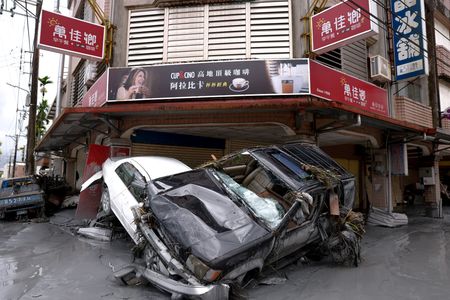(Reuters) -A barrier lake in Taiwan's mountainous and sparsely populated east coast county of Hualien burst on Tuesday as the outer edges of Super Typhoon Ragasa pounded the island bringing heavy rainfall, killing 15 people so far in a flood.
Here are some facts about the lake.
WHAT IS A BARRIER LAKE?
Barrier lakes are formed when rocks, landslides or other natural blockages make a dam across a river, normally in a valley, blocking and holding back water, hindering or even stopping natural drainage.
WHEN WAS THE HUALIEN LAKE FORMED?
The existence of the lake in its current form was discovered in July after being spotted from satellite monitoring, having been formed when earlier typhoons caused landslides blocking a valley and causing water to pile up behind it.
WHERE IS THE LAKE LOCATED?
The lake is in a remote part of the mountains above the town of Guangfu on a tributary of the Matai'an Creek.
HOW BIG IS THE LAKE?
Before it overflowed this week, the dam forming the lake stood approximately 120 metres (390 ft) high, with the water behind it covering an area 500 metres (1,600 ft) long, and 1,650 metres (5,400 ft) wide.
It has since shrunk in size by about 75%. The government said the overflow of the barrier lake released about 60 million tonnes of an estimated 91 million tonnes of water, enough to fill about 36,000 Olympic-sized swimming pools.
WHY WAS THE LAKE NOT DEALT WITH BEFORE IT OVERFLOWED?
Given the lake is in a very remote area that is both hard and dangerous to access, it proved difficult for the government to take steps to reduce the water level and clear the rubble.
Some parts of the mountains in Hualien remain unstable after a 7.2 magnitude quake hit the region last year, Taiwan's biggest earthquake in at least 25 years.
Sources: Taiwan government, Central News Agency
(Reporting by Ben Blanchard;Editing by Alison Williams)







